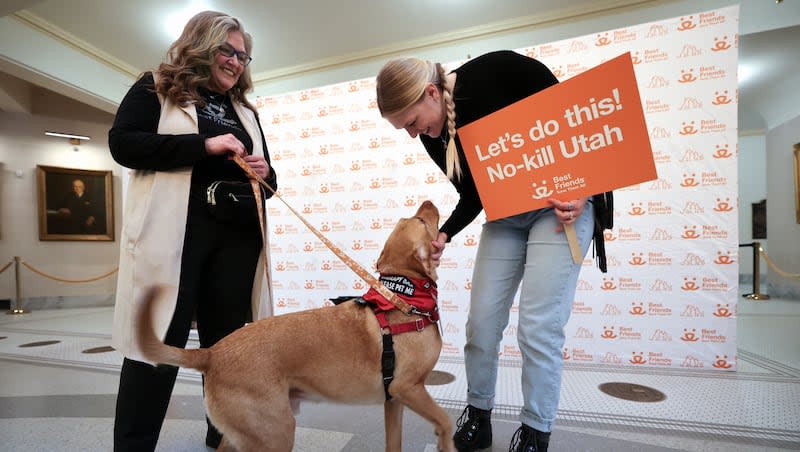Utah to become largest no-kill state in country, Gov. Cox declares

- Oops!Something went wrong.Please try again later.
Dogs and Best Friends supporters and staff filled the Hall of Governors Tuesday to celebrate Gov. Spencer Cox declaring 2024 as no-kill shelter year in Utah.
“Whereas, achieving no-kill for all of Utah’s animal shelters is within reach, and would make Utah the largest no-kill state and the first no-kill state in the West,” Cox wrote, “Now, therefore, I, Spencer J. Cox, governor of the state of Utah, do hereby declare 2024 as no-kill shelter year in Utah.”
The declaration encourages animal shelters to change policies to save pets’ lives. A no-kill state means that the shelters within the state save the lives of pets they house. According to data from Best Friends, 47 out of 60 shelters across the state are no-kill. So far, 45,538 furry friends have been saved. The total save rate is 87.8%, while 1,700 cats and dogs have been killed. This data was formulated from shelters’ most recent data (in years 2021, 2022 or 2023).
Julie Castle, CEO of Best Friends, pointed toward an adopted dog named Sunny in her remarks and said, “There is a lot of stuff in this world that does not bring peace. I can tell you that one thing that brings you peace is saving that life right there.”
Sunny joined Castle near the podium as she explained Sunny might have been killed years back if Sunny was taken into a shelter. “This dog Sunny is here because we believe that we can do this,” Castle said.
Castle recalled when she started at Best Friends in 1996, Utah was a long way off from being a no-kill state. In 1999, Best Friends decided to work to Utah a no-kill state. Given the geographical size of Utah and how many municipal shelters there are, Castle said it was hard work.
“We literally drove from county to county meeting with every single shelter and asking ‘How many animals do you have in the shelter? How many are dying? How many are making it out alive?’” Castle said.
Stephen Lisonbee, senior advisor for rural affairs in Cox’s office, said, “We are beyond thrilled for this year’s declaration in hopes that the remaining communities can come together and understand of what can happen when you become a no-kill community.”
Lisonbee related that as his older kids have moved out, his younger kids have started spending more time with the family dog.
Brittany McCabe, the shelter manager at Cedar City Animal Adoption Center, encouraged the audience to volunteer at animal shelters.
“Volunteering at the shelter is not just walking dogs or cleaning cages. It’s offering love, compassion and a second chance to enjoy life. Your time and dedication can turn the shelter into a place of hope, transforming the lives of these animals one day at a time,” McCabe said.
Going no-kill doesn’t just save pet lives, it offers a reduced cost to budgets, Talia Butler, director of Salt Lake County Animal Services, said. “The millions of dollars that we’ve received and the sustainable programs that make Utah —that is all because of the no-kill mission.”
Throughout the last few years, Utah animal shelters have increasingly become no-kill.
One of the difficulties shelters face is an overpopulation of cats. “Shelters really struggle because they get an influx of kittens during the summer months that it’s hard for them to have the capacity to handle them,” Holly Sizemore, chief mission officer at Best Friends Animal Society, told the Deseret News.
Trap-neuter-return policies and community cat programs have helped shelters save the lives of cats.
Community cats are just what they sound like — the community provides food and water for the cat while the cat roams around the neighborhood.
Another option is trap-neuter-return. Sometimes there are cat colonies, a group of three or more feral cats who roam around together. They have a territory they cover and these cats will fend for themselves in terms of resources. Shelters sometimes will trap these cats, neuter them and then return them to their colonies after their ears are snipped.
“The vast majority of (cats that adoption centers get) are feral. And then those rescues and shelters are doing sterilization and getting those kittens adopted,” Natalie Orr, board member at Celestial Zoo Pet Rescue, told the Deseret News. “So by cutting off the supply, by getting these animals fixed, we are helping to reduce the number of cats that are just coming in.”
Fostering and adopting are another way to help.
“Fostering is a great short-term commitment for people who can’t bring home a pet permanently, but can for a couple of weeks,” Guinn Shuster, director of marketing at the Humane Society of Utah, said. “That often helps the shelters open up space for an animal that can move through in that same time and get adopted.”

